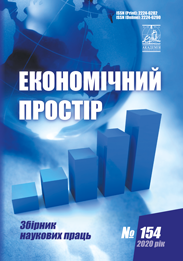TERRITORIAL DEVELOPMENT OF LAND USE IN THE REGION: EXPERIENCE OF COASTAL REGIONS OF CHINA
Abstract
The necessity of ensuring the territorial development of land use is proved. The relevance of substantiating the experience of ensuring the territorial development of land use in the regions of China is determined. The purpose of the study is to determine the theoretical base and research experience in ensuring the territorial development of land use in coastal regions of China. The objectives of the study in the context of achieving the goal are: substantiation of theoretical and methodological approaches to the determination of the territorial development of regional land; identification of the peculiarities of ensuring the territorial development of the territory of land, taking into account the experience of coastal regions of China Given the theoretical basis for determining the territorial development of the use of land in the regions, taking into account the features of the functioning of coastal cities, the territorial development model, where spatial, urban, investment and environmental factors are determined, forms the appropriate quantitative basis and applies modern information systems. The necessity of developing a high-quality innovative technology to ensure the territorial development of the use of land in the regions is explained, it connects system spatial, urban planning, investment and environmental factors, modern methods and models, geographic information tools, which is a geofactorial analysis. The analysis has identified spatial, urban, investment and environmental factors, established criteria for their selection. The model of territorial development is proposed, given the experience of land use in coastal regions of China.
References
Офіційний сайт Департаменту містобудування та архітектури м. Харкова URL: http://www.dma.kh.gov.ua/planning/kadastr (дата звернення: 20.03.2020).
Державні будівельні норми України. Склад та зміст містобудівного када-стру ДБН Б 1.1-16:2013 URL: http://dbn.at.ua/load/normativy/dbn/1-1-0-1035 (дата звернення: 20.03.2020).
Про регулювання містобудівної діяльності : Закон України від 17 люто-го 2011 р. № 3038-VI / Верховна Рада України URL: http://zakon2.rada.gov.ua/laws/show/3038-17 (дата звернення: 20.03.2020).
Enemark, S, Updating digital cadastral maps – The Danish experience / FIGcongress, Brighton 1998.
Williamson, I. The justification of cadastral systems in developing countries. Geomatica. 1997 Vol. 51, № 1. pp. 21–36.
UNATED NATIONS: Inventory of Land Administration Systems in Europe and North America / Forth Edition, Produced and published by HM Land Registry, London, on behalf of the UNECE Working Party on Land Administration, July, 2005.
Лихогруд М.Г. Структура й особливості формування кадастрового номера земельної ділянки та іншої нерухомості. Землевпорядний вісник. 2000. № 4. С. 64–68.
Ho S., Rajabifard A., Stoter J., Kalantari M. Legal barriers to 3D cadastre implementation: What is the issue? [Text] / Land Use Policy. 2013. Vol. 35, N. 1. pp. 379–387.
Oosterom P. Research and development in 3D cadastres [Text] / Environment and Urban Systems. 2013. Vol. 40, N. 1. pp. 1–6.
Данилишин Б. М. Екологічна складова політики сталого розвитку: монографія. Донецьк : Юго-Восток, Лтд, 2008. 256 с.
Шипулін В.Д. Основні принципи геоінформаційних систем: навчальний посібник. Харків : ХНАМГ, 2010. 313 с.
Dumanski, J. International Workshop on Sustainable Land Management for the 21st Century: Summary. Workshop Proceedings. Ottawa : Agricultural Institute of Canada, 1994. pp. 50.
Pieri, C., Dumanski, J., Hamblin, A., and Young, A. Land Quality Indicators. World Bank Discussion Paper. no. 315. Washington : World Bank, 1995. pp. 51.
Smyth, A.J. and Dumanski, J. FESLM: An international framework for evaluating sustainable land management. A discussion paper. World Soil Resources Report 73., Rome : Food & Agriculture Organization, 1993. pp .74.
Rural Development. From Vision to Action. ESSD Studies and Monographs Series 12., Washington : World Bank, 1997. pp 157.
Ofitsiinyi sait Departamentu mistobuduvannia ta arkhitektury [Official Website of the Department of City Planning and Architecture]. Available at: http://www.dma.kh.gov.ua/planning/kadastr (accessed 20 March 2020).
Derzhavni budivelni normy Ukrainy. Sklad ta zmist mistobudivnoho kadastru DBN B 1.1-16:2013 [DBN B.1.1-16:2013. Sklad ta zmist mistobudivnoho kadastru. State Construction Norms of Ukraine]. Available at: http://dbn.at.ua/load/normativy/dbn/1-1-0-1035 (accessed 20 March 2020).
Pro rehuliuvannia mistobudivnoi diialnosti : : Zakon Ukrainy vid 17 liutoho 2011 r. # 3038-VI / Verkhovna Rada Ukrainy [On Regulation of Urban Plan-ning Activity: Law of Ukraine of February 17, 2011 No. 3038-VI / The Verkhovna Rada of Ukraine] Available at: http://zakon2.rada.gov.ua/laws/show/3038-17 (accessed 20 March 2020).
Enemark, S. (1998). Updating Digital Cadastral Maps: the Danish Experience. Proceedings of the FIG XXI International Congress, Commission 7: Cadastre and Land Management, July 19-25, 1998, Brighton. Jessica Kingsley Publishers, pp. 426–437.
Williamson, I. (1997). The justification of cadastral systems in developing countries. Geomatica, no. 51(1), pp. 21–36. Available at:: http://www.csdila.unimelb.edu.au/publication/misc/anthology/article/artic9.htm (accessed 20 March 2020).
UNECE Working Party on Land Administration. (2005). Inventory of Land Administration Systems in Europe and North America. Ed. 4. London: HM Land Registry, pp. 250. Available at:: http://www.unece.org/index.php?id=10952 (accessed 20 March 2020).
Lykhohrud, M. H. (2000). Struktura y osoblyvosti formuvannia kadastrovoho nomera zemel-noi dilianky ta inshoi nerukhomosti [Structure and features of formation of cadastral number of land plot and other real estate]. Zemlevporiadnyi visnyk. no. 4, pp. 64–68.
Ho, S., Rajabifard, A., Stoter, J., Kalantari, M. (2013). Legal barriers to 3D cadastre implementation: What is the issue? Land Use Policy, 35, pp. 379–387. DOI: 10.1016/j.landusepol.2013.06.010.
Van Oosterom, P. (2013). Research and development in 3D cadastres. Computers, Environment and Urban Systems, no. 40, pp. 1–6. DOI: 10.1016/j.compenvurbsys.2013.01.002.
Danylyshyn, B. M. (2008). Ekolohichna skladova polityky staloho rozvytku [Environmental component of sustainable development policy]. Donetsk: Yuho-Vostok, pp. 256.
Shypulin, V. D. (2010). Osnovni pryntsypy heoinformatsiinykh system [Basic principles of geoinformation systems]. Kharkiv: KhNAMH, pp. 313.
Dumanski, J. (1994). International workshop on sustainable land management for the 21st Century. Land Use Policy, vol. 11 no. 2, pp. 142–145. DOI: 10.1016/0264-8377(94)90008-6.
Pieri, C., Dumanski, J., Hamblin, A., Young, A., UNEP UNDP. (1996). Land Quality Indicators. World Bank Discussion Papers, no. 315. The World Bank, pp. 51.
Smyth, A. J., Dumanski, J., Spendjian, G., Food and Agriculture Organization of the United Nations. (1993). FESLM: An International Framework for Evaluating Sustainable Land Management: a discussion paper. Rome: Land and Water Development Division, Food and Agriculture Organization of the United Nations, pp. 74.
McCalla, A. F., Ayres, W. S. (1997). Rural development. Washington: The World Bank, pp. 157. DOI: 10.1596/0-8213-3966-4.



